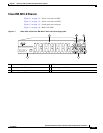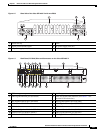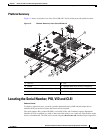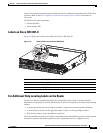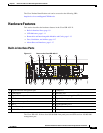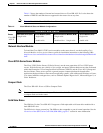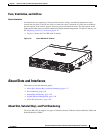
1-10
Hardware Installation Guide for the Cisco 4451-X Integrated Services Router
OL-27644-01
Chapter 1 Overview of the Cisco 4451-X Integrated Services Router
Hardware Features
Front Panel Ethernet Ports
There are 4 front panel Ethernet ports. Each port independently supports dual-media types, RJ45 copper
or SFPs.
Dual Mode GE/SFP Ports
There are Dual Mode ports available on the Cisco ISR 4451-X that can function as GE or SFP ports.
GE Ports
The GE RJ-45 copper interface ports support 10BASE-T, 100BASE-TX, and 1000BASE-T.
SFP Ports
The small-form-factor pluggable (SFP) ports support, but are not restricted to 1000BASE-LX/LH,
1000BASE-SX, 1000BASE-ZX, and Coarse Wavelength-Division Multiplexing (CWDM-8) modules, as
well as 100Mbs SFP modules.
The SFP port shares the same physical port as an RJ-45 GE port with the same number. It can only be
used for one or the other function at one time. The SFP port supports auto-media-detection, auto-failover
and remote fault indication (RFI), as described in the IEEE 802.3ah specification.
Use the media-type {rj45{auto-failover}} | {sfp{auto-failover}} command to enable the
auto-media-detection and auto-failover features. Use the Command Lookup Tool for details about this
command.
The SFP port can be configured for the following behaviors:
• Always use the RJ-45 port.
• Always use the SFP port.
• Always use the RJ-45 port but fail over to the SFP port if the RJ-45 port fails. This is the default
configuration.
• Always use the SFP port but fail over to the RJ-45 port if the SFP port fails.
USB Serial Console Port
The Mini-USB type B serial port can be used as an alternative to the RJ45 console port. For Windows
operating systems older than Windows 7, you must install a Windows USB device driver before using
the USB console port.
Front Panel PoE+ Ports
Two of the four front panel ethernet ports are PoE+ (802.3at) compliant ports. These are ports GE 0/0/0
and GE 0/0/1.
System PoE power supplies do not provide power to the front panel ports.
Note The PoE card is always required to provide PoE power to these ports, regardless of what other power
supplies are present in the system. An internal PoE module needs to be ordered separately for this
functionality.





